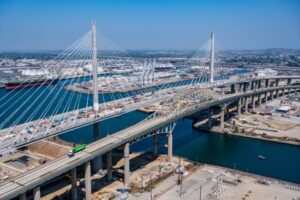PHOTO: PORT OF LONG BEACH
BY STAS MARGARONIS
Infrastructure investments during the Biden administration closed the shortfall in U.S. infrastructure investments, including roads, bridges, ports, inland waterways, and aviation, but if Congress reverses that investment trend, the result could be “$5 trillion lost in gross economic output over 20 years”, according to the American Society of Civil Engineers (ASCE).
ASCE also warns that cutbacks could result in: “a reduction of $244 billion in U.S. exports in those same years.”
On March 25th, ASCE released A Comprehensive Assessment of America’s Infrastructure: 2025 Report Card for America’s Infrastructure which states: “ASCE estimates investment needs total $9.1 trillion for all 18 Report Card categories to reach a state of good repair. Public data and ASCE’s 2024 Bridging the Gap study forecast $5.4 trillion in public and private investments in the 10-year period, 2024 through 2033, if Congress continues recent funding levels. This leaves a gap of $3.7 trillion in investments for America’s infrastructure if we keep investing at current funding levels.”[1]
In the two Water Transportation categories, Inland Waterways and Ports, “$45 billion would support a full state of good repair, and $32 billion was the anticipated investment over the next 10 years. That leaves a $13 billion gap.”[2]
Cutbacks in Federal Infrastructure Investments Could Be Serious
On the other hand, ASCE warned that if Congress cuts spending on infrastructure, the consequences could be serious: “However, if Congress were to snap back to investment levels in place prior to recent increases in federal spending, that gap would increase significantly. In fact, ASCE’s Bridging the Gap study, which assesses just 11 of the 18 categories in the 2025 Report Card, finds that the snapback gap would equal the entirety of the 2025 Report Card gap: $3.7 trillion. That figure does not include broadband, dams, levees, hazardous and solid waste, parks, and schools, which represent, at a minimum, an additional gap of $746 billion for a total of $4.4 trillion. Additionally, in that snapback scenario, ASCE estimates meaningful economic harm: $5 trillion lost in gross economic output over 20 years, from 2024-2043, and a reduction of $244 billion in U.S. exports in those same years.”
The negative impact would also result in lost income to American families by returning to: “Pre-2021 levels of federal investment also mean a job loss of 344,000 in one snapshot year of 2033. The reduced investments would result in $1.9 trillion in lost disposable income for American families within the 20 years studied.”[3]
ASCE Report Card Findings
In the Report Card, ASCE made the following findings on the status of U.S. infrastructure based on an A to F grading system:
Aviation D+
Bridges C
Broadband C+
Dams D+
Drinking Water C-
Energy D+
Hazardous Waste C
Inland Waterways C-
Levees D+
Ports B
Public Parks C-
Rail B-
Roads D+
Schools D+
Solid Waste C+
Stormwater D
Transit D
Wastewater D+[4]
Investments Under The Biden Administration
ASCE found that there had been a growing investment gap in infrastructure prior to 2021: “We needed to reverse the nation’s growing infrastructure investment gap to remain competitive in the global marketplace, allow local businesses to thrive, and keep our families safely connected. That message grew louder with each evaluation, through our most recent Report Card release in early 2021.”[5]
Under the Biden administration, Congress passed authorizations for infrastructure investment and this gap was narrowed: “… in late 2021, the trend began to change. Congress passed the Infrastructure Investment and Jobs Act (IIJA), the most comprehensive federal investment in the nation’s infrastructure in U.S. history… A few years later, IIJA investments and policy changes are already improving the performance of our transportation, water, energy, and waste networks. As a result, nearly half of the grades are increasing for the 18 categories we assess in this 2025 Report Card for America’s Infrastructure. This forward momentum is due in large part to the actions of the federal government in partnership with state and local governments and the private sector. Unfortunately, while significant advancements are being made, we still face a substantial investment gap. The shortfall grows as existing infrastructure systems continue to age and demands on those systems increase.”[6]
Climate Change Requires New & Increased Investments
The report noted that infrastructure is facing a new challenge because climate change generating “extreme weather” is placing additional stresses on transportation and other infrastructure systems:
“Aging infrastructure systems are increasingly vulnerable to natural disasters and extreme weather events, creating unexpected and often avoidable risks to public safety and the economy. Climate-related challenges are widespread, affecting even regions previously resistant to these events: floods become more intense and occur more often, hurricanes create higher wind loads, and wildfires encroach more unpredictably. Investments in resilient infrastructure are consistently proven to be an effective use of limited public dollars, because they reduce costs in the long term, especially by minimizing rebuilding needs after a significant event. For instance, by adopting the most up-to-date codes and standards, communities will be better equipped to handle disasters and more responsibly deploy public resources.”[7]
Planning for these events means spending more now to reduce the damage later:
“In addition, passage of the IIJA has shed light on key issues affecting our industry. Projects should be modernized or replaced by prioritizing resilience to withstand extreme weather. Resilience focused measures may add to upfront costs but save on sudden, less predictable, and large financial impacts from disaster-related damages. Infrastructure projects take a long time to develop, and stakeholders may hesitate to pursue resilient designs without assurances that current funding levels will be sustained in the future. These are just a few of the challenges we continue to face.”[8]
FOOTNOTES
[1] https://infrastructurereportcard.org/wp-content/uploads/2025/03/Executive-Summary-2025-Natl-IRC-WEB.pdf P.8
[2] P.8
[3] p.8
[4] P.7
[5] P.1
[6] PP. 1-2
[7] ASCE 2025 Report Card p.6
[8] P.2

